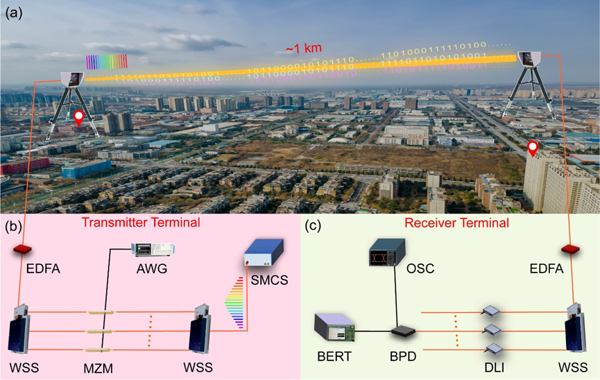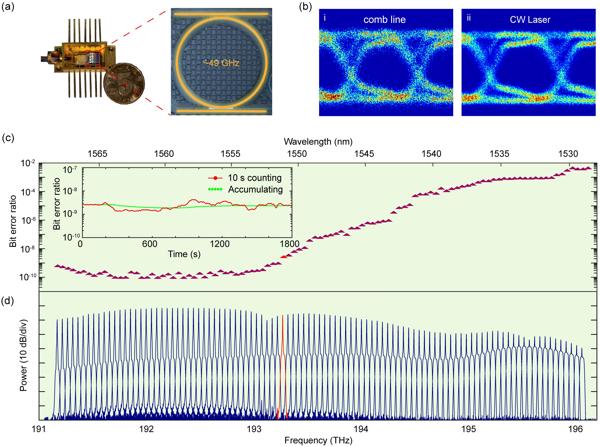Free-space optical communication (FSOC) uses laser beam as a carrier for information transmission in space. FSOC takes the merits of large communication capacity, anti-electromagnetic interference, good confidentiality, large license-free bandwidths compared with microwave communication system. The communication terminals have the advantages of small volume, easy deployment, and low power consumption, which is an ideal candidate for "last mile" information transmission. It has important application values in emergency, space-to-ground and inter-satellite communications.
It is a research hotspot to realize large capacity FSOC systems with high data rate and long transmission distance. Wavelength division multiplexing (WDM) technology is well developed to improve data transmission capacity using the large spectrum resources. Generally, many individual lasers are employed as optical carriers, whose wavelength should be carefully controlled for inter-channel guard bands. Therefore, the volume and power consumption would largely increase for a FSCO system.
To address this problem and achieve large-capacity FSO communication, the research group led by Prof. Xiao-Ping Xie and Wei Wang from the Laboratory of Photonics and Network, cooperating with Prof. Wen-Fu Zhang and associate Prof. Wei-Qiang Wang from the State Key Laboratory of Transient Optics and Photonics, Xi'an Institute of Optics and Precision Mechanics, Chinese Academy of Sciences, a Tbit/s parallel FSO communication system was implemented using a soliton microcomb as a multiple wavelength laser source.
The relevant research results are published in Photonics Research, Volume. 10, Issue 12, 2022 (Wen Shao, Yang Wang, Shuaiwei Jia, Zhuang Xie, Duorui Gao, Wei Wang, Dongquan Zhang, Peixuan Liao, Brent E. Little, Sai T. Chu, Wei Zhao, Wenfu Zhang, Weiqiang Wang, and Xiaoping Xie. Terabit FSO communication based on a soliton microcomb[J]. Photonics Research, 2022, 10(12): 2802).
On-chip soliton combs (SMCs) have large repetition rate and all the comb tones are intrinsically equidistant in frequency, which are ideal integrated laser sources for massively parallel signal transmission in FSOC system. In this work, 102 comb lines of a SMC are selected as optical carriers and modulated with 10 Gbit/s differential phase-shift keying modulation signals. Figure 1 shows the setup of a FSOC system with 1.02 Tbps communication capacity and ~1 km transmission distance.

Fig. 1. The schematic of soliton microcomb based massively parallel FSOC system. (a) The experiment scenario of the FSO communication system. (b) The schematic diagram of the transmitter terminal. (c) The schematic diagram of the receiver terminal.
The SMC is pumped by a laser with linewidth of ~100 Hz and generated using the well-developed auxiliary laser-assisted thermal balance scheme. The SMC is long time survived by control the temperature and the frequency between pump and auxiliary lasers. The SMC has a repetition rate of ~48.97 GHz, which is multiplexed and demultiplexed using wavelength selective switches. The bit error rate (BER) performance is compared at different received power using a continuous-wave laser and a comb line (1558.093 nm) as optical carriers respectively. The measured BERs are comparable for power less than -30 dBm and Fig. 2(b) shows the received eye diagram respectively. The 1.02 Tbps parallel data transmission using 102 comb lines. Figure 2d shows the measured optical spectra of the 102 individually modulated comb lines. And the BERs results are shown in Fig. 2c, where 42 comb lines achieve of BERs are less than 10-9.

Fig. 2. 1.02 Tbit/s free-space data transmission using a soliton microcomb. (a) The image of a butterfly-packaged device (left panel) and the high-index doped silica glass MRR (right panel). (b) Measured eye diagram at received power of −26 dBm for comb line (1558.093 nm) and CW laser. (c) Measured BERs for 102 optical channels. The inset shows the measured real-time BER curve (red) with 10 s counting time, as well as the accumulating BER curve (green) for the comb line of 1551.192 nm. (d) The measured optical spectra of the modulated 102 optical signals after amplified and filtered at the transmitting terminal.
Prof. Xiaoping Xie said: "SMC has the characteristics of small volume, wide spectrum, high repetition rate and low noise. It has a prospect in the application fields of large-capacity optical communication, optical clock, precision ranging and spectroscopy. SMC is used as an on-chip multi-wavelength light source for FSOC communication in this work. It is significant to improve the communication capacity and solve the size, weight and power (SWaP) problems of an FSOC system. It provides a new scheme for the future large capacity and long distance FSOC."


